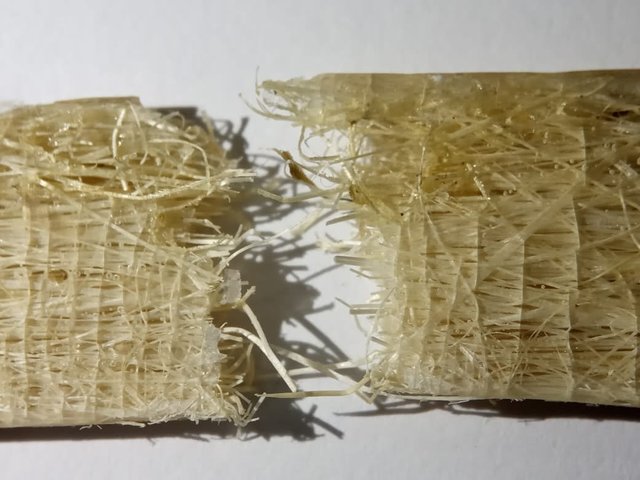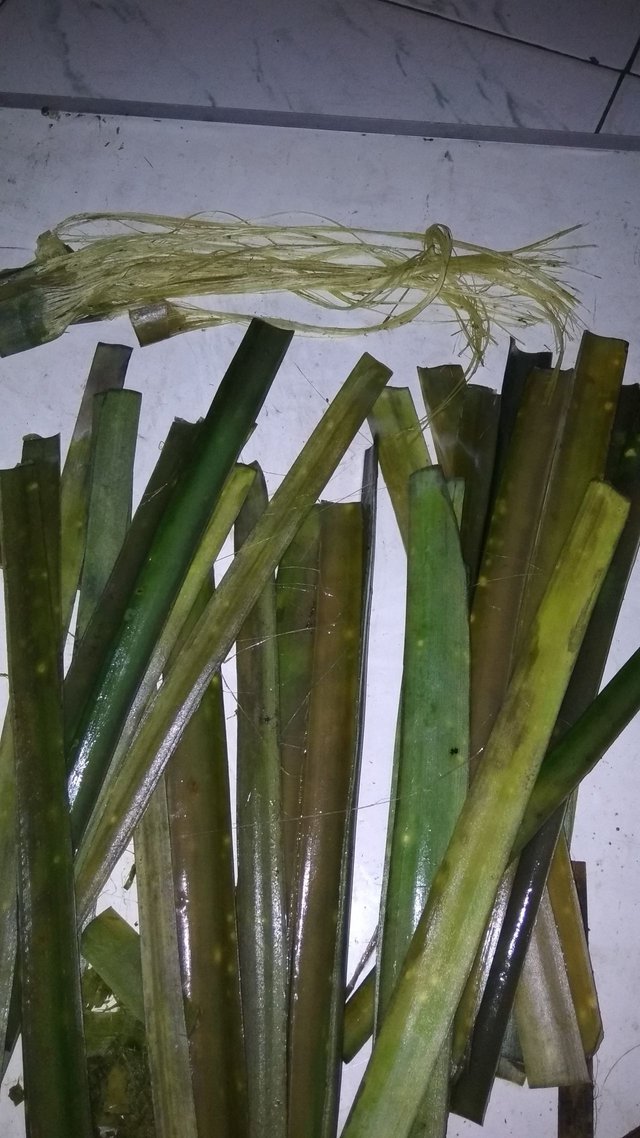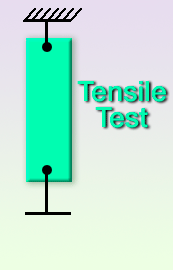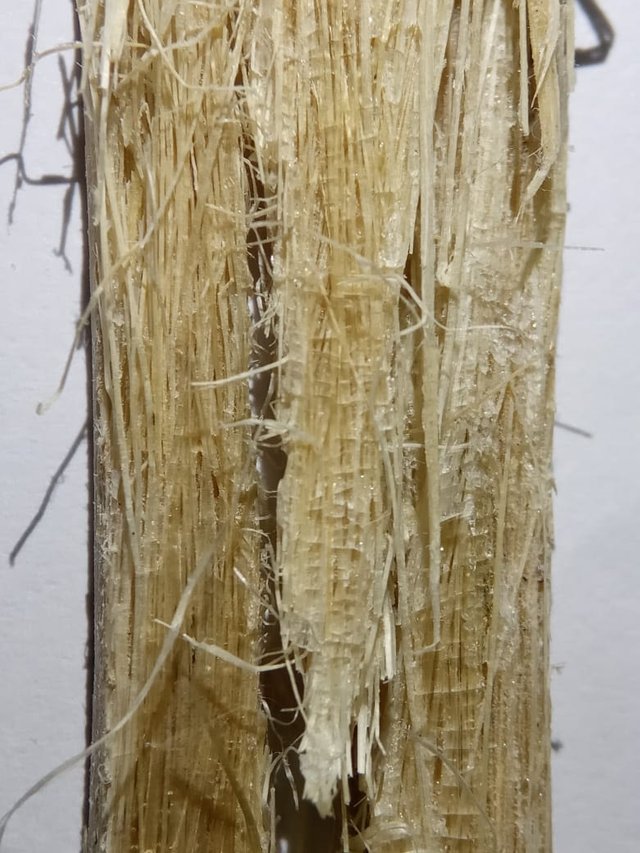Analysis of the tensile strength of polyester pineapple leaf fiber composites by setting different fiber directions
The purpose of this study was to make a polymer composite with pineapple leaf fiber reinforced fiber alignment aligned and random with a variation of volume fraction of 20%, 30%, and 40%.
Test specimens were made using the hand lay-up method with press molding. Composite testing in the form of a tensile test refers to the ASTM D 638-02 Standard to find out the mechanical properties of composites and to know the results of the macro type photo of pineapple fiber composite with the parallel and random arrangement.
Pineapple is one of the most cultivated fruit plants in the tropics and subtropics, the largest export volume for horticultural commodities is processed pineapple, which is 49.32% of Indonesia's total horticultural exports in 2020.
>Research conducted by the Industrial Plant Research Institute, the average yield of one hectare is around 36 tons of wet stems with yields between 3.5% - 4.0% so that the final yield is estimated to be around 1.3 tons/ha of dry fiber.Pineapple per hectare per year of 125 tons consists of 40% (50 tons) green leaves and 60% (75 tons) wet stems. From the wet stems, 3.5% (2,625 tons) of dry fiber will be produced and 16% of the waste (12 tons) will be produced.Source
For the people of Indonesia, pineapple is part of their lives, because all parts of the plant can be used to meet economic needs. In addition, the importance of the community is also reflected in the vast area of smallholder plantations which reaches 47% of 3.74 million hectares and involves more than three million farmer households. Pineapple exploitation also opens additional employment opportunities from the activities of processing various derivative products and by-products.
This research uses pineapple fiber filler, the type of binder used is a polyester resin. Polyester resin is a thermoset resin that is easily obtained and used by the general public as well as small and large scale industries.
This polyester resin also has the ability to bind to natural fibers without causing reaction and gas, therefore polyester resin is used in this study.
In order to make a natural fiber composite material that has good mechanical properties, it must be known that the composition factors that influence in making the composite material.
Based on the description above, it is necessary to do further research to determine the tensile strength of polyester pineapple leaf fiber composites with aligned and random fiber direction.
Making a new material that is in line with expectations will require several tests, in this study the writer will formulate several problems as follows:
- The amount of tensile strength of polyester pineapple leaf fiber composite material?
- What is the right arrangement so that you get the right manufacturing after the tensile test?
To limit this research, this research focuses only on the problem:
- Composite in pineapple fiber arranged with a fiber volume fraction of 20%, 30%, and 40% with 5% alkalization treatment within 2 hours.
- Using polyester resin type BQTN-157-EX.
- Types of fiber arrangements used are parallel and random.
- Composites are made using the manual method (hand lay-up).
- Composite testing in the form of a tensile test refers to ASTM D638-02 Standard.
The term composite often also includes material in which the second phase has the form of particles or lamina. In cases like this, the composite structure promises special benefits, besides strength, it also has economic value and corrosion resistance. The history of various composite technologies records innovative findings, even amazing ideas.
Example: plastic filling material, plastic-coated steel sheet.
Composite is a material or material combined between two or more types of material with different phases. This combination is intended to obtain composite materials with better properties than the constituent materials. In composites known as the matrix (first phase) and reinforcement (second phase).Source Composite
Fiber composites are composites composed of fibers in a matrix. Naturally, long fibers have more strength than bulk fibers. It is a type of composite that consists of only one lamina or one layer that uses reinforcement in the form of fiber.
The fiber used can be in the form of glass fibers, carbon fibers, aramid fibers, and so on. These fibers can be arranged randomly or with certain orientations or even more complex shapes such as webbing.
Fiber is a material that has a ratio of lengths to very high diameters and diameters close to crystals, fibers also have strength and stiffness to large densities. The need for different fiber placement and fiber direction makes the fiber-reinforced composite differentiated into several sections.
The volume fraction (%) is a comparison rule for mixing the volume of fiber or powder and the volume of the matrix-forming material against the total volume of the composite. Usually, the use of the term volume fraction refers to the percentage (%) of the volume of reinforcement or reinforcement material used in the composite manufacturing process.
One very important factor in determining the characteristics of composite materials is the content or percentage between the matrix and fiber. Before doing the composite printing process, the calculation of the fiber volume fraction (Vf), and the matrix volume fraction (Vm) is first calculated.Souce
Pineapple leaf fiber is a type of fiber derived from plants obtained from the leaves of pineapple plants. Pineapple plants that also have another name, namely Ananas Cosmosus, are generally included in the type of annual plants.
Pineapple leaves have an outer layer consisting of the upper and lower layers. Between these layers, there are many bonds or strands of fiber that are bound to one another by a type of adhesive found in the leaves.
Because pineapple leaves do not have leaf bones, the presence of fibers in the pineapple leaves will strengthen the pineapple leaves as they grow.
Macro photos are very close-up photography to get high details without the need for optical magnifiers such as microscopes or magnifying devices. Macro photography usually has a ratio of 1: 1 ie the size of the resulting image is the same size as the original object.
Composite Macro Photo functions to observe the fracture shape on each specimen due to tensile testing, the purpose of doing macro photography is to determine the failure that occurred on the composite. In addition, a macro photograph was also carried out to see the fracture characteristics of tensile testing results on the composite.
Tensile testing is a measurement of material to determine the toughness and toughness of a material to certain stress and increase in length experienced by the material. In the tensile test, both ends of the test object are clamped, one end connected to a tension device.
Tensile testing aims to obtain load and elongation values that are useful in the process of calculating the tensile strength of composites. In addition, tensile testing aims to determine the macro failures that occur in the specimen. Source
The process is undertaken to prepare a work plan to be carried out, the initial step is to carry out a field survey of things related to the research to be conducted. In addition, in this process, the design of the specimen molds was made to make specimens in the form of variations of the arrangement.
The process of making pineapple fiber composites with a polyester matrix is as follows:
- Pineapple fiber preparation. Cutting in accordance with the size of the length of the mold with a parallel and random arrangement.
- Mold making. Mold specimens use glass thickness of 5mm, mold size is 24 cm long, 14 cm wide and 3.2 mm thick.
- Polyester resins are mixed with a catalyst to help the drying process. The catalyst used is 1% of the amount of polyester resin used.
- The material that is turned into a matrix is placed in a mold, then the resin is poured out evenly on all parts.
Pull Test Result Data
Based on the results of tensile tests that have been carried out using the standard ASTM D-638-02 on pineapple fiber-reinforced composites (5% NaOH) optimization of fiber volume fraction 20%, 30% and 40% with tensile stress, tensile stretch, and elastic modulus obtained.
The lowest tensile strength is in test specimen number 1 with a value of 4.57 MPa with a yield strength of 70.26 MPa. The highest tensile strength is in test specimen number 3 with a value of 5.69 MPa with a yield strength of 21.46 MPa.
Based on the testing of specimens for volume fractions of 20%, 30%, and 40%, it was found that the tensile strength varies according to the volume fraction of the composite.
The tensile strength is greatly influenced by the volume fraction and arrangement of fibers so that with increasing volume fraction in each specimen it will also increase the tensile strength of the composite.
The composition of the fiber is the thing that most determines the results of the tensile strength and yield strength of the composite, we can see that the results of the tensile testing of the composite fiber alignment have an increase in value according to the volume fraction.
To observe the fracture shape on each specimen due to tensile testing, visual observations were made on each specimen's fracture surface.
From the results of tensile testing of composite reinforced pineapple fiber parallel and random arrangement with a volume fraction of 20%, 30%, and 40% can be seen several different forms of specimen fracture, the release of fibers from the matrix before the composite is broken at the time of tensile testing.
Slitting in multiple area fracture conditions meet the strength standards of natural fiber composites with good compatibility.
In areas that have the weakest adhesion bond between the fiber and the matrix in the composite causing the fiber to be separated from the matrix, resulting in pull out.
Conclusion
The results of this study can be concluded as follows:
- Pineapple Fiber-reinforced composite strength tensile arrangement of 20%, 30%, and 40% volume fraction has the highest tensile strength at 40% volume fraction with an average value of σ = 9.07 MPa, tensile strain ε = 17.02%. The lowest tensile strength at the volume fraction = 20% with an average value of σ = 5.13MPa, tensile strain of ε = 45.86%. In the volume fraction of 20%, 30%, and 40%, the tensile strength of the composite increased according to the percentage of the volume fraction.
- Pineapple fiber-reinforced composites with a random arrangement of 20%, 30%, and 40% volume fraction has the highest tensile strength at 40% volume fraction with an average value of σ = 4.37 MPa, tensile strain ε = 52.30%. The lowest tensile strength at a volume fraction of 30% with an average value of σ = 2.55 MPa, the tensile strain of ε = 76.36%. In the 20% volume fraction shows the composite tensile strength increased above the 30% volume fraction tensile strength value with an average value of σ = 2.83 MPa, tensile strain ε = 67.05%. This is caused by the random arrangement of the fibers so that there are uneven parts of the fibers.
- The results obtained in this study, the exact manufacturing arrangement that is right on the pineapple fiber composite is with an alignment with an average tensile strength value of 20.06 MPa. As for the random arrangement, it has a tensile strength of 9.75. The results of this study are clearly superior alignment than a random arrangement.
Source
https://en.wikipedia.org/wiki/Fiber-reinforced_composite
https://www.scielo.br/scielo.php?script=sci_arttext&pid=S0100-29452014000300022
https://www.researchgate.net/post/how_to_calculate_Volume_fraction_of_matrix_in_a_hybrid_composites
https://www.mtu.edu/materials/k12/experiments/tensile/
https://media.neliti.com/media/publications/176235-EN-effect-of-fiber-volume-fraction-of-tensi.pdf




This post has been rewarded by the Steem Community Curation Project. #communitycuration07
Thank you Steem Community Curation Project.
#communitycuration07